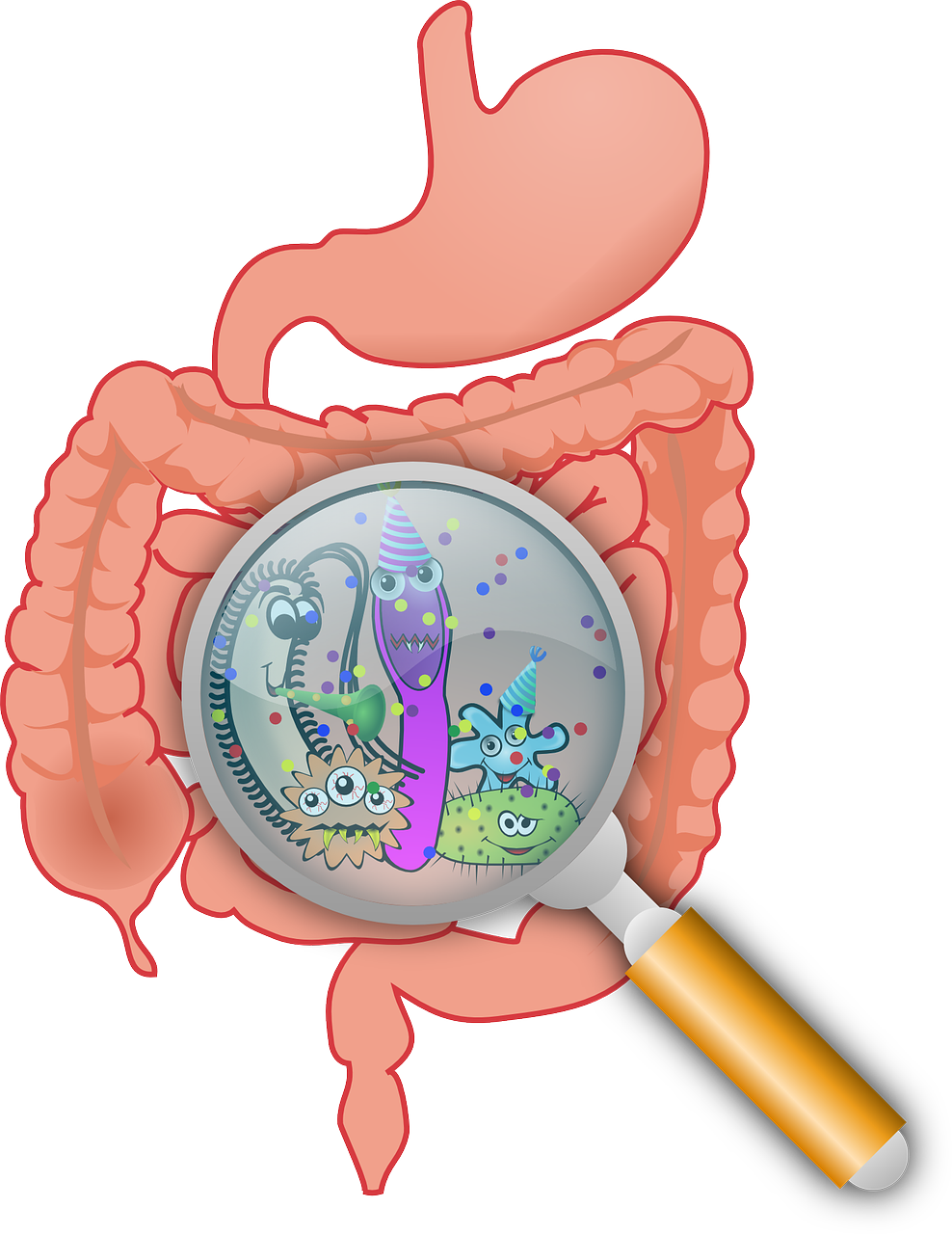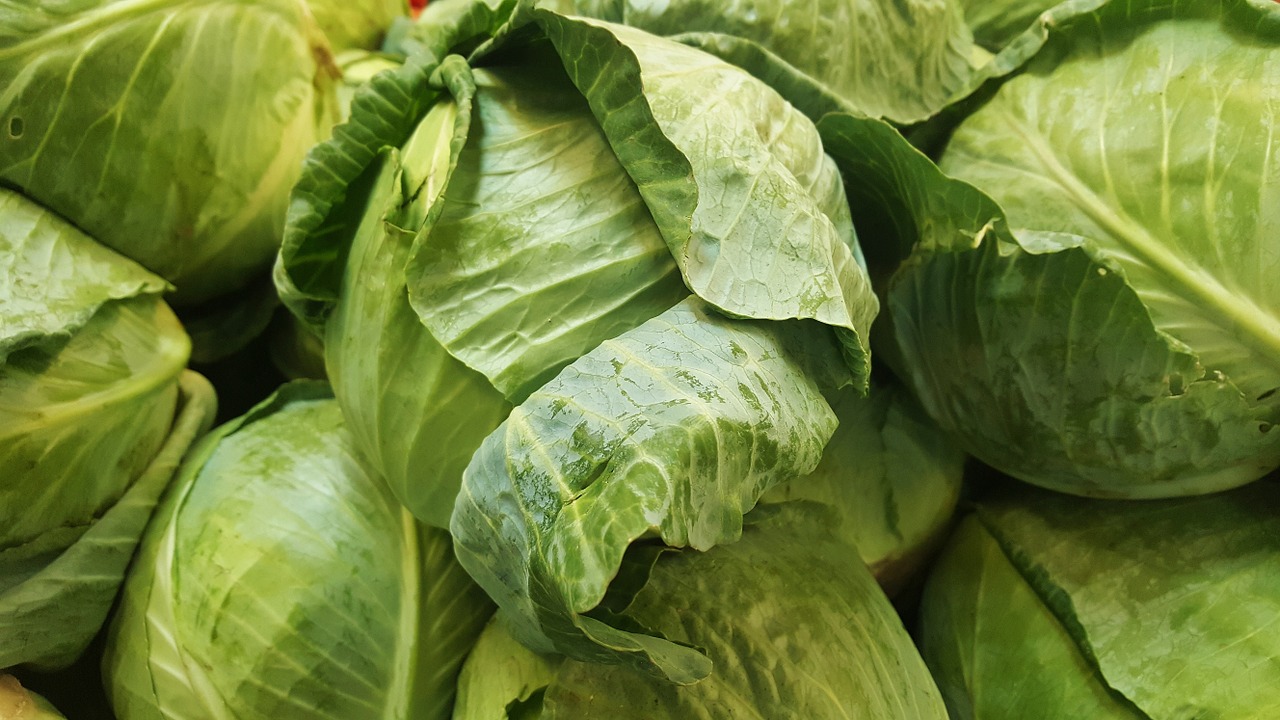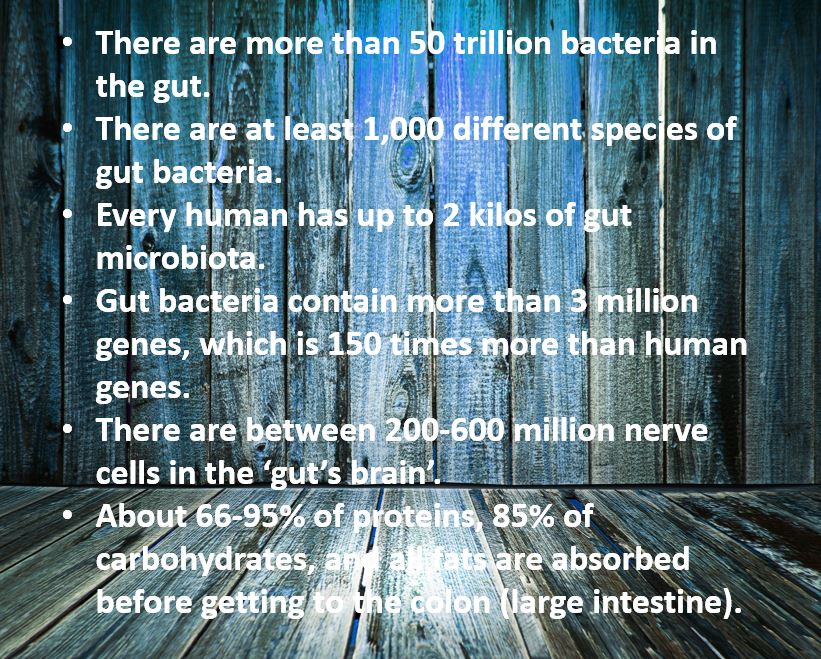Get to know your gut - 10 interesting facts
Nov 15, 2018
Posted by: Monique Parker

The gut and its inhabitants, the gut flora or also called the gut microbiome, are a fascinating part of our bodies. We are learning more and more every day about the influence of the gut on how our body functions, and how a healthy gut can improve our physical and mental health and well-being.
Get to know your gut. Here are some interesting facts that you might not know.
1. THE HOUSEKEEPER’S WAVE

Every 90 minutes, in between meals, when you’re not eating, you can hear a rumbling or gurgling sound. No, you’re not necessarily hungry, it is very likely the Migrating Motor Complex, also called the ‘housekeeper’s wave’. Undigested food and waste, but also excess bacteria, are being cleaned up from your small intestine. This is necessary to make sure that your gut bacteria won’t be able to feed of the debris and grow out of control.
Studies have shown that people with IBS often have a problem with their Migrating Motor Complex. When the ‘housekeeper’s wave’ is not working properly, you will end up with an overgrowth of bacteria in your gut. This called SIBO (small intestinal bacterial overgrowth). It is thought that SIBO is one of the main causes of Irritable Bowel Syndrome.
2. THE SECOND NERVOUS SYSTEM
Inside your gut you have a second nervous system which is called the enteric nervous system (ENS), or ‘the gut’s brain’. This nervous system has about 500 million nerve cells, which is lot less than the brain which has about 100 billion nerve cells. These cells are located in the tissue lining the oesophagus, stomach, small and large intestine.
The gut talks to the brain, and vice-versa, via nerves and chemical messengers. For example, when you’re nervous or anxious, you often lose your appetite, or you have digestive issues such as diarrhoea. And who hasn’t had ‘butterflies’ in their stomach before?
There are more than 30 neurotransmitters made in the gut by the ENS. The ‘gut’s brain affects sleep, memory and mood for instance, so an unhealthy gut can have unpleasant effects on your mental health.
3. THE HAPPY HORMONE

The neurotransmitter serotonin is sometimes called the ‘happy hormone’, because it is involved in controlling your mood. But actually only 10% of serotonin is produced in the brain. The other 90% of serotonin is made in the gut by certain cells and bacteria, and it helps to regulate your bowel function and movements, but it is also involved in reducing appetite while you’re eating. Foods that increase serotonin levels are tryptophan-rich food (tryptophan is needed to make serotonin) such as turkey, chicken, cheese, tofu, red meat, fish, oats and eggs, but also high-fibre foods to make your good gut bacteria happy.
4. GUT BACTERIA AND WEIGHT GAIN
Research suggests that there are certain gut bacteria that play an important role in the way nutrients are absorbed and how the energy (calories) from the food we eat is regulated, in relation to obesity. For instance, the bacteria slow down movement of food through the gut to get as many nutrients out of it as possible, or they silence an enzyme called lipoprotein lipase that reduces the ability of fat cells to take fatty acids and triglycerides from the blood, which causes more fat to be stored in the body.
In other words, certain gut bacteria, i.e. Firmicutes, obtain more energy from the food you eat than others.
Research showed that when bacteria-free mice were given gut bacteria from normal mice, there was a huge increase in the amount of body fat. When you look at the gut bacteria of lean and obese people, you will see a difference in the composition of the gut microbiota.
It is interesting that when people eat the exact same food, they react differently to it because of their different composition of gut bacteria.
5. THE USEFUL APPENDIX
Many people think that the appendix is a useless body part. We probably all know someone who lost their appendix after falling ill with appendicitis. But the appendix is actually very useful. It contains a large number of immune cells that help get rid of harmful bacteria. The appendix is also a storage place for good bacteria. When someone has food poisoning and bad diarrhoea, the appendix will supply good bacteria to repopulate the gut.
6. FABULOUS FIBRE

When you eat food that contains fibre, it is the ‘friendly’ gut bacteria in the colon that are feasting on it. When the bacteria are feasting on the fibre, they produce short-chain fatty acids such as butyrate and acetate. These are very beneficial as they provide energy to the cells in the large intestine and strengthen the gut barrier. Butyrate also helps balance the immune cells in your gut and reduces inflammation. You find butyrate in good old butter (the real thing, not margarine), ghee (clarified butter) and prebiotic foods such as vegetables (Jerusalem artichokes, leafy greens, leeks, onions etc.), under-ripe bananas, cooled cooked potatoes, legumes, buckwheat, millet and quinoa.
7. THE GUT AND YOUR IMMUNE SYSTEM
About 70% of our immune system is located in and around the gut wall (the lining of the intestines). Our digestive system is in direct contact with the outside world and pathogens (disease causing microorganisms) are easily ingested. The route from mouth to anus, the gastrointestinal tract, is covered by a single layer of cells that allow nutrients to be absorbed but could also be a potential entry point for the invaders. So luckily the gut lining and our gut microbiota are defences against these invaders. Balanced gut bacteria are important for a well-functioning immune system.
8. HOW IT ALL STARTS

Your gut microbiome is formed during the first couple of years of your life. When you were in your mother’s womb, your gut was more or less sterile, without gut bacteria. Research has shown that it is quite possible that colonisation of gut microbes actually does start in the womb. What we do know is that you will have picked up gut bacteria during birth and shortly after, from your mother (vaginal, faecal, breast milk, mouth, skin) and your surroundings. That is why a natural birth through the birth canal is so much better for the start of a good gut microbiome, as you are picking up bacteria along the way that will settle in your gut. If you were born by Caesarean section, you have missed that process and the first microbes you came into contact with, were those coming from your surroundings, i.e. those in the hospital or the ones on the skin of the nurse that held you.
It is thought that around three years of age, your gut microbiome is at adult levels. This is all influenced by how you were born, what your mum passed on to you, your nutrition and health status. Your initial gut inhabitants may determine what your gut microbiome looks like throughout life.
9. THE MORE VARIED THE MERRIER
Why is it so important to have a diverse gut microbiome?
According to Professor Tim Spector of King’s College London, compared to our ancestors who lived in the countryside, eat rich and varied diets, and didn’t take antibiotics, our gut microbiome is only a fraction of what theirs was. Negative changes in the composition of the gut microbiome have been associated with ill health. The more varied our diet is, the more diverse the gut microbiome will be.
Our gut flora can convert energy from nutrients into new molecules that interact with us and the wider the range of signals, the more likely it is we can stay in a healthy state when our food intake is not so good.
If you temporarily exclude certain nutrients, the diversity will only be reduced for a short time. However, if you decide to eliminate nutrients for a long time, the losses of the gut bacteria cannot be undone. For instance, cutting out fermentable fibre will reduce the diversity of your gut microbiome dramatically.
Another example is carbohydrates. Cutting out sugar and starch can be beneficial for people with diabetes, but they need to be replaced with indigestible or complex carbohydrates as the gut bacteria could still use those as food/fuel.
Professor Spector describes the gut microbiome as a rainforest, that needs diversity to have good soil. “…..it’s having the right community of bacteria that are working together and together producing the right chemicals for your body.”
10. SOME FIGURES

Be good to your gut and it will be good to you. Eat a varied, healthy diet with plenty of plant foods, fermented foods, fibre and other nutrient-dense foods.






